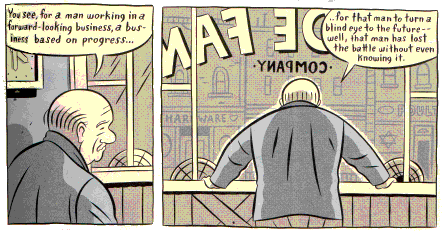

| February 1998 |
|
| Seth : Palookaville | |
The current series in Palookaville is called Clyde Fans. It's about as unlikely a subject for comics (or anything else) you could think of: An old man recounts the story of his life as a salesman and later manager of a tiny, failed Canadian fan manufacturer.
 If Hollywood did a story like that, they'd gussy it up with flashbacks, character actors, celebrity cameos, and sentimentality. Seth does none of that; the visuals simply follow the old man as he goes about his daily routine, occasionally focussing on small details-- a portrait, a sculpture-- and addresses the reader on whatever strikes his fancy: anecdotes about salesmanship, what exactly was wrong with his brother Simon, radio and TV and what they have to do with why the company failed.
If Hollywood did a story like that, they'd gussy it up with flashbacks, character actors, celebrity cameos, and sentimentality. Seth does none of that; the visuals simply follow the old man as he goes about his daily routine, occasionally focussing on small details-- a portrait, a sculpture-- and addresses the reader on whatever strikes his fancy: anecdotes about salesmanship, what exactly was wrong with his brother Simon, radio and TV and what they have to do with why the company failed.
And it works, due to Seth's writing and storytelling skills. It takes an unusual sensibility to find the universal human interest, not in the spectacular and the eccentric, but in the everyday, the obscure, and the ordinary. The art is simple but accomplished, and done in a beautiful two-color palette.
The sympathy of imagination displayed here is truly rare in comics-- and in modern literature. Rather than one more autobio of a struggling urban cartoonist, Seth asks us to identify with a bourgeois businessman; and the voice he finds for the old man rings true: practical, a little formal, but also reflective and without bitterness. When he talks about sales, he sounds like a salesman, not a cartoonist.
Most of the previous issues were collected in a TPB, It's a Good Life, If You Don't Weaken. It's a more personal story, about Seth's own obsession with an obscure Canadian cartoonist named Kalo, who appeared at least once in the New Yorker, and then drifted out of cartooning... hey, this is sounding a little like "Clyde Fans".
Seth himself is melancholic, seemingly happy only in perusing old books and magazines and wandering through run-down old manufacturing districts. (It's not the past per se he likes; it's the patina of the past-- the very fact that it is faded and half-forgotten.)
He also doesn't seem to do any better than Joe Matt with women-- though for quite different reasons. He lets them slip through his fingers.
Their mutual friend Chester Brown appears here as sounding board and role model. Now I'm wondering-- if I read Brown will he turn out to idolize Joe Matt?
Can you judge a comic by its letters column? Jim Woodring's correspondents all seem to be quirky and non-linear-- Sarah Dyer's are gushy and cute-- Dave Sim's are long-winded and argumentative-- Seth's are intense, philosophical, and devotees of dead masters.
Update-- After reading Good life, I thought about combing old issues of the New Yorker for Kalos. I wish I had; I'd have discovered something interesting. Based on a hint posted to rac.alternative, I went to the libes today and looked at issues of the New Yorker for April 1951, when Kalo's cartoon appeared-- page 37 of one of the weekly issues, as we see from the Kalo collection in the back of the book. Guess what: it's not there. Kalo is fictional. Huh.When I mentioned this to my wife she commented, "He's a Borges." True enough: plausibly inserting a minor cartoonist into the past is rather Borgesian.
| Mark Crilley: Akiko | |
These elements are not exactly new, nor is the treatment deep; but it's all done with humor and great style, and it's beautifully drawn.
This is an all-ages comic, so you could give it to a ten-year-old or an adult without fear; only teenagers will recoil from it.
I think this is the first time I've seen a comic with soft focus effects. There's a lot of use of screens and computer enhancement-- but used the right way: not for their own sake, but to enhance the visuals.
There's one serious flaw: more than once Akiko saves the party from some hideous monster by scolding it severely. This simply makes no sense to an adult, and is not the way to write for children either, I think.
